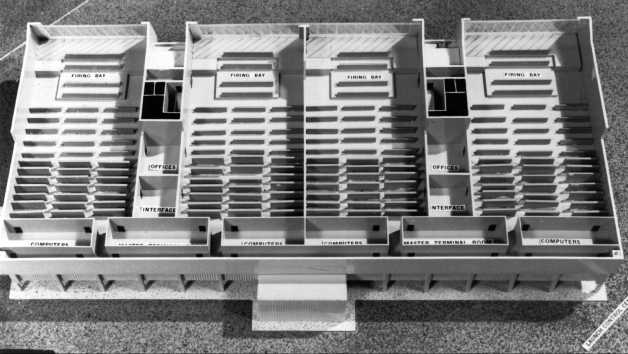
Launch Control Center Design
URSAM also designed the launch control center, which presented far fewer problems than the VAB. The Manned Space Flight Management Council established ground rules for the design of the building in a meeting on 22 June 1962. Originally, the launch control center was to be placed at ground level in the western section of the low bay of the VAB. In October 1962, a suggestion to place it on the roof of the high bay held up the planning. An URSAM estimate that locating the center on the roof of the high bay would mean an additional expense of $1,200,000 ended the discussion. The structure was built on the southeastern side of the VAB with a long hallway connecting the two. The original plans called for a steel structure, but the structural engineers recommended concrete as better for acoustical purposes, and the final choice was a 114 x 55-meter, four-story, monolithic, reinforced-concrete building that made extensive use of precast and prestressed elements.25

Sketch of the launch control center, February 1963. The large shutters along the front of the upper floor could be closed quickly, in the event of an emergency.
The architects wanted the launch control center to be symbolic. The VAB was to be the factory, and the control center was to be man's window for observing events projecting into the future. The four multilevel firing rooms were rectangular in shape, 28 meters in width and 46 meters in length. Since many checkout requirements were still unknown, the planners emphasized flexibility, eliminating all columns and providing removable floors.26
The design of the windows shut off the sounds and pressures of the outside world. Two-centimeter-thick glass windows with adjustable sun visors in special aluminum frames faced the launch area. Infrared lamps outside the windows prevented fogging. The tinted, laminated windows, which covered an area 24 meters long and 7 meters high, filtered out heat and glare, permitting only 28% of the light to enter the room. Transparent glass, separating a viewing section from the rest of the firing room, gave guests a feeling that they were part of the operation. For its efforts on the launch control center, URSAM won the 1965 Architectural Award for the industrial design of the year.27

Model of the proposed launch control center, February 1963.
While URSAM was designing the buildings, LOC engineers were determining what equipment would go inside. The control center's display stations were initially projected at a 13 September 1962 meeting between LOC representatives and Huntsville's Astrionics Division. Display consoles would monitor such things as propulsion, navigation, measuring, ordnance, propellant loading, ground support equipment, and emergency detection. Rack requirements included countdown clock, TV and communications, and discrete recorders. Criteria for the ten consoles located in each firing room for the control, test, and monitoring of the mobile launcher's electrical support equipment were furnished by the Launch Support Equipment Engineering Division. The design and fabrication of the panels were the responsibility of the Astrionics Laboratory at Marshall.28
During the following year, the emphasis shifted from a systems-oriented firing room to one organized by flight stage or hardware. Nearly 450 consoles would be operated by representatives from the stage contractors and Radio Corporation of America, General Electric, Saunders, Symetrics, International Telephone and Telegraph, NASA, and the Eastern Test Range. The consoles were arranged to permit the Boeing, North American, and other teams of engineers to sit together in their respective stage groupings. Responsibility for designing the consoles rested primarily with the various companies, but the designs were coordinated by LOC. W. O. Chandler, Jr., Deputy Chief of the Electrical Systems Branch, recalled making at least 25 trips to Houston and other Apollo offices to make certain that design change information for the consoles was current.
| Next |